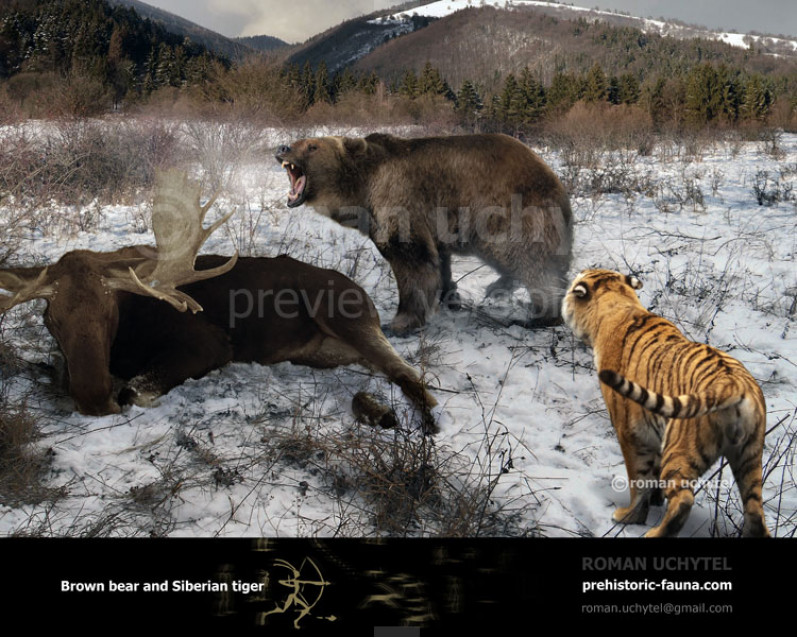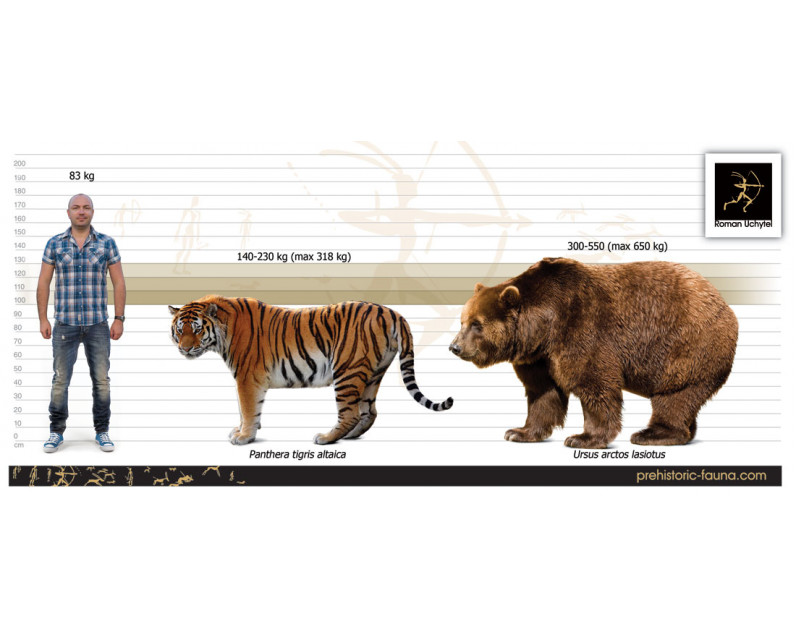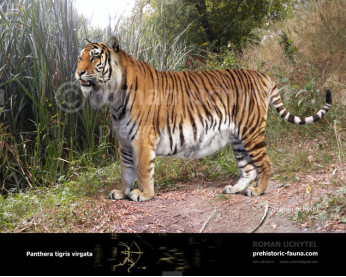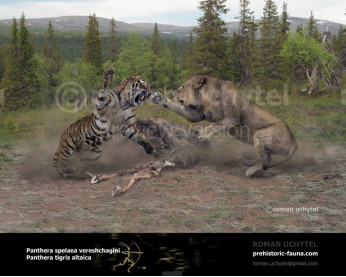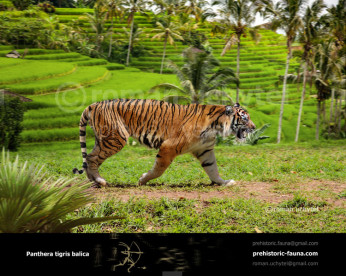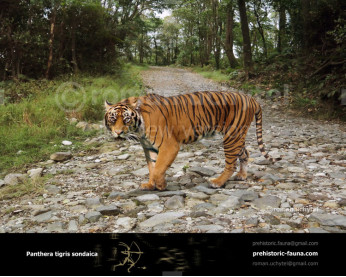Brown bear and Siberian tiger
28762876Siberian tiger, Amur tiger (Panthera tigris altaica Temminck, 1884)
Order: Carnivora
Family: Felidae
Range and period of existence: Late Pleistocene - Holocene of North-East Asia
Dimensions: length - 1.9 m, tail length - 90 cm, height - 90 -115 cm, weight - 160–225 kg (max 306 kg)
A comparison of data on body weights of wild Siberian tigers indicates that up to the first half of the 20th century both males and females were on average heavier than post-1970 ones. Today's wild Siberian tigers are smaller than Bengal tigers. Their reduced weight as compared to historical Siberian tigers may be due to a combination of causes: when captured, they were usually sick or injured and involved in a conflict situation with people.
The largest wild male, with largely assured references, was a Manchurian which was killed in the area of Sungari River in 1943. It measured 350 cm "over the curves", equivalent to 330 cm "between the pegs", and weighed no less than about 300 kg. The tail length in fully grown males is about 1 m. Weights of up to 318 kg have been reported, and exceptionally large males weighing up to 384 kg are mentioned in the literature, but none of these cases was confirmed in reliable sources. The typical weight range of Siberian tigers is indicated as 160–230 kg for males and 100–167 kg for females.
Ussuri brown bear (Ursus arctos lasiotus)
Order: Carnivora
Family: Ursidae
Dimensions: length - 2,8 m, height - 125 сm, weight - 400 to 550 kg
Temporal range: 0.5–0 Ma. Russia: southern Kuril Islands, Sakhalin, Maritime Territory, and the Ussuri/Amur River region south of the Stanovoy Range, China (former Manchuria): Heilongjiang, Japan: Hokkaidō, Honshu (in the last glacial period), Korean Peninsula: North Korea. Became extinct on Rebun and Rishiri Islands in the 13th century.
Siberian tiger, Amur tiger (Panthera tigris altaica Temminck, 1884)
Order: Carnivora
Family: Felidae
Range and period of existence: Late Pleistocene - Holocene of North-East Asia
Dimensions: length - 1.9 m, tail length - 90 cm, height - 90 -115 cm, weight - 160–225 kg (max 306 kg)
A comparison of data on body weights of wild Siberian tigers indicates that up to the first half of the 20th century both males and females were on average heavier than post-1970 ones. Today's wild Siberian tigers are smaller than Bengal tigers. Their reduced weight as compared to historical Siberian tigers may be due to a combination of causes: when captured, they were usually sick or injured and involved in a conflict situation with people.
The largest wild male, with largely assured references, was a Manchurian which was killed in the area of Sungari River in 1943. It measured 350 cm "over the curves", equivalent to 330 cm "between the pegs", and weighed no less than about 300 kg. The tail length in fully grown males is about 1 m. Weights of up to 318 kg have been reported, and exceptionally large males weighing up to 384 kg are mentioned in the literature, but none of these cases was confirmed in reliable sources. The typical weight range of Siberian tigers is indicated as 160–230 kg for males and 100–167 kg for females.
Ussuri brown bear (Ursus arctos lasiotus)
Order: Carnivora
Family: Ursidae
Dimensions: length - 2,8 m, height - 125 сm, weight - 400 to 550 kg
Temporal range: 0.5–0 Ma. Russia: southern Kuril Islands, Sakhalin, Maritime Territory, and the Ussuri/Amur River region south of the Stanovoy Range, China (former Manchuria): Heilongjiang, Japan: Hokkaidō, Honshu (in the last glacial period), Korean Peninsula: North Korea. Became extinct on Rebun and Rishiri Islands in the 13th century.

